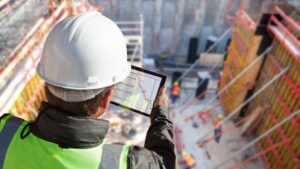overlaying digital information onto the physical world, AR technology is transforming traditional building processes, making them more efficient and less error-prone. This innovative approach not only enhances visualization but also improves accuracy and speeds up decision-making on construction sites.
Augmented Reality Construction
Augmented Reality (AR) construction integrates digital visualization into physical building environments, enhancing both precision and efficiency. This section explores the foundational elements and the latest tools in this transformative technology.
The Basics of Augmented Reality
 Augmented reality in construction refers to the technology’s ability to combine real-world environments with digital data using AR devices. These systems project images, metrics, and other relevant information onto physical spaces, typically through wearable devices like smart glasses or through mobile devices. AR allows, for instance, a user to see holographic representations of future structures overlaid on a current construction site, streamlining the planning and building phases.
Augmented reality in construction refers to the technology’s ability to combine real-world environments with digital data using AR devices. These systems project images, metrics, and other relevant information onto physical spaces, typically through wearable devices like smart glasses or through mobile devices. AR allows, for instance, a user to see holographic representations of future structures overlaid on a current construction site, streamlining the planning and building phases.
Key components include AR software that processes data, AR headsets that display the information, and sensors that map the physical space to align digital and real-world views. Engineers and architects use AR to visualize architectural changes before they’re implemented, which minimizes errors and reduces the need for costly corrections.
Current Technologies and Tools
The array of technologies and tools available for AR in construction has grown extensively, supporting more nuanced and precise applications. Examples include:
- Spatial Computing Devices: These devices, like the Microsoft HoloLens and Magic Leap, offer robust AR experiences by understanding and interacting with physical spaces in three dimensions.
- Mobile AR Apps: Apps such as Autodesk’s BIM 360 Glue allow stakeholders to upload 3D models of their projects and view them on-site through tablets or smartphones.
- AR Smart Glasses: Devices such as Google Glass and Vuzix Blade are designed for hands-free operations, enabling workers to access information while engaged in physical tasks.
Benefits of Augmented Reality in Construction
Improved Accuracy and Efficiency
 Augmented reality introduces a new level of precision in construction by overlaying detailed 3D models onto the physical construction sites. These AR models help workers see the end results in context before the construction even begins, allowing for adjustments in design and placement with a high degree of accuracy. Consequently, this minimizes the risk of errors and rework, which saves time and resources. For instance, using AR headsets, technicians can visualize piping systems in walls or structural reinforcements in real-time, ensuring that everything fits correctly according to the specifications. This application not only speeds up the construction process but also enhances the overall quality of the project.
Augmented reality introduces a new level of precision in construction by overlaying detailed 3D models onto the physical construction sites. These AR models help workers see the end results in context before the construction even begins, allowing for adjustments in design and placement with a high degree of accuracy. Consequently, this minimizes the risk of errors and rework, which saves time and resources. For instance, using AR headsets, technicians can visualize piping systems in walls or structural reinforcements in real-time, ensuring that everything fits correctly according to the specifications. This application not only speeds up the construction process but also enhances the overall quality of the project.
Enhanced Safety on Construction Sites
AR significantly improves safety on construction sites by providing virtual warnings and real-time hazard alerts. Construction workers equipped with AR devices can receive instant notifications about potential dangers, such as weak scaffolding or open electrical circuits, directly in their field of view.
Challenges and Limitations
Technical Challenges
 Implementing AR in construction involves complex technical hurdles. First, ensuring the accuracy and stability of AR technology on construction sites poses a significant challenge. AR systems rely heavily on high-quality data inputs to provide accurate visual overlays. Inaccuracies in GPS or sensor data can lead to misalignments, impacting the utility and trustworthiness of AR applications. Second, environmental factors such as lighting conditions, physical obstructions, and outdoor weather can affect the performance of AR devices. Maintaining clarity and visibility of AR projections in bright sunlight or over long distances often proves difficult. Lastly, AR requires substantial computing power and robust software that can handle detailed 3D models and the real-time processing of large datasets. The need for powerful hardware that can withstand construction environments adds another layer of complexity.
Implementing AR in construction involves complex technical hurdles. First, ensuring the accuracy and stability of AR technology on construction sites poses a significant challenge. AR systems rely heavily on high-quality data inputs to provide accurate visual overlays. Inaccuracies in GPS or sensor data can lead to misalignments, impacting the utility and trustworthiness of AR applications. Second, environmental factors such as lighting conditions, physical obstructions, and outdoor weather can affect the performance of AR devices. Maintaining clarity and visibility of AR projections in bright sunlight or over long distances often proves difficult. Lastly, AR requires substantial computing power and robust software that can handle detailed 3D models and the real-time processing of large datasets. The need for powerful hardware that can withstand construction environments adds another layer of complexity.
Adoption and Integration Issues
The integration of AR technology within established construction workflows presents another challenge. Resistance to change is a common issue in industries with longstanding traditional methods. Convincing stakeholders of the benefits of AR technology over conventional techniques, and training workers to use new tools effectively demand significant time and resources. Additionally, integrating AR with existing IT systems and ensuring compatibility with various software used for project management and design can be problematic.

